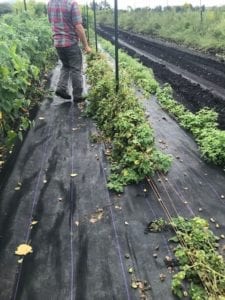Physalis Blog Post
Survey, Superfoods, and Fruit Drop
Harvest Season Survey
As we make our way into the fall season, many are reporting that their Physalis plants have ripe fruit! With the harvest season underway, we want to hear from you about your observations throughout the course of the project. If you were a participant, please fill out our survey, to the best of your ability. At the end of the survey there will be an option for you to provide any other comments that you would like to share.
Survey Link : https://www.surveymonkey.com/r/physalisproject
Goldenberry, A New Superfood?
Last week Nestlé formally acquired a 60% stake in the Ecuadorian company Terrafertil, that happens to be the world’s largest buyer of goldenberries (Physalis peruviana). So what happens when the world’s largest food company connects with the worlds largest buyer of goldenberries? The prospect of a new superfood is born! Nestle plans to incorporate goldenberries into many of its already well-known products, including chocolate! The company was attracted to the prospect of goldenberries due to strong nutritional profile and hopes to use goldenberries to expand upon their portfolio of health conscious foods. To learn more about this read the full article below!
Nestlé may find goldenberry is the next superfood
Nestlé, the world’s largest food company, may be looking at the goldenberry as its next superfood candidate, according to Bloomberg. The focus on the yellow berry that’s roughly the size of a marble comes as Nestlé recently purchased a 60% stake Terrafertil is the in the Ecuador-based Terrafertil , a natural and organic plant-based food company.
>
Navigating Fruit Drop
Aptly named, groundcherries are known for dropping their fruit. This naturally occurs as the fruit reaches maturity, but can also happen prematurely, expecially in instances where the plant is disturbed by an external force (i.e. wind). Thus the ripe fruit ends up on the ground, putting the fruit at risk of damage and/or contamination, and creating a labor intensive harvest process.
So how do some farmers deal with it? One of our project participants J & A farm has used a combination of trellising, black plastic ground cover, and a broom increase the efficiency of the labor process. The plants are trellised up to minimize their sprawl, and the black plastic prevents the fruit from touching the bare ground, creating a surface that can easily be swept. Dropped fruit are then swept up and collected for harvest. Last year using these methods they harvested over 300 pounds of groundcherries that were then sold wholesale to regional buyers.

Groundcherry planting at J&A Farm
Other techniques for improving harvest conditions have also been explored. A 2015 grant from Sustainable Agriculture Research and Education (SARE) allowed a Maryland CSA farm to explore different techniques for increasing harvest efficiency, minimizing fruit damage, and minimizing food safety issues. In this study, they used a combination of trellising, pruning, grafting, and netting (to catch the fruit) to try and improve the harvest of groundcherries, and concluded that these methods could improve the overall harvest process. The full report of the study can be found here.

